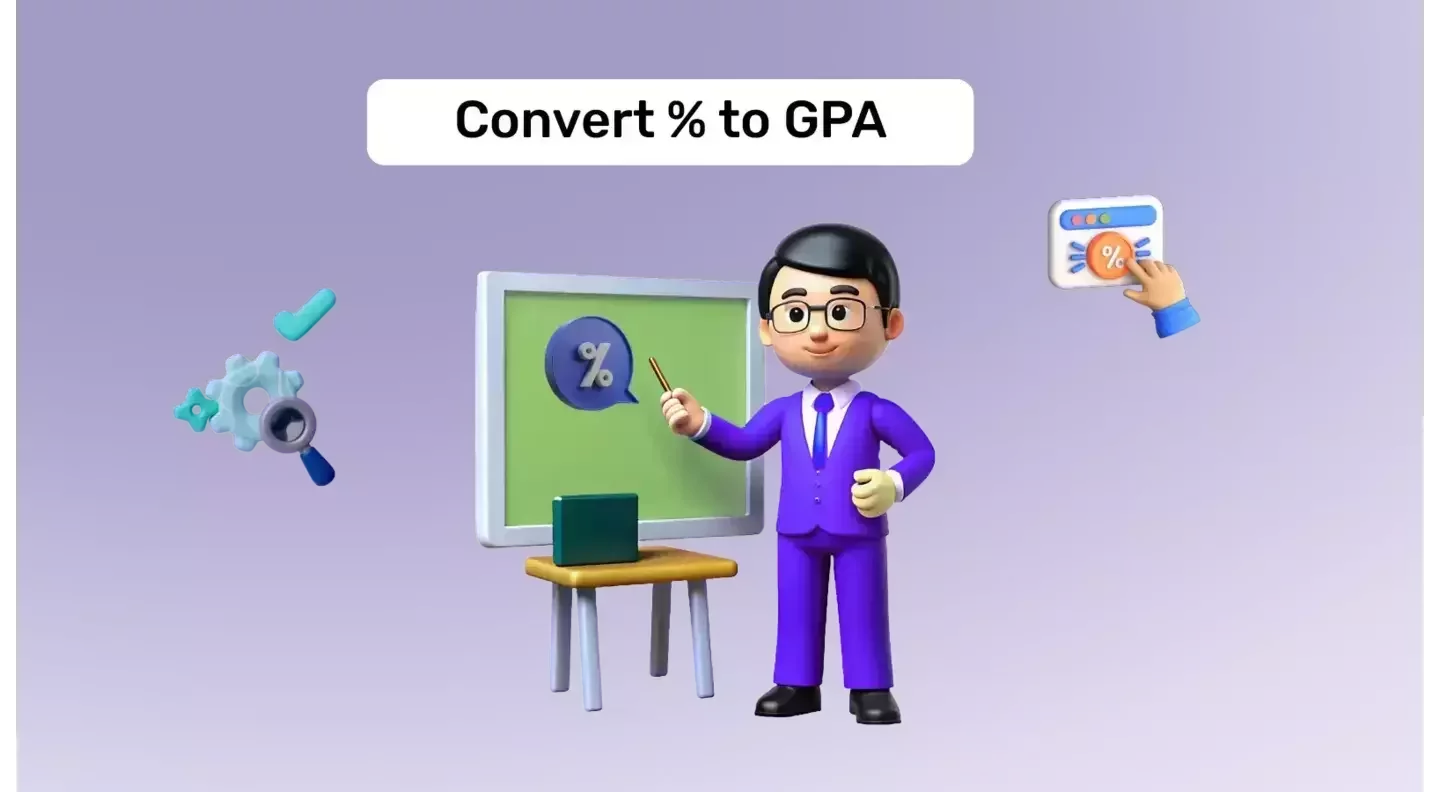Get instant loan offer suitable to your profile !


On this Page:
Learn how is GPA calculated in India and convert the Indian percentage to GPA with GyanDhan’s GPA calculator India.
Key takeaways from the blog:
 GPA, the grading metric in the US and Canada offers a standardized assessment of academic performance.
GPA, the grading metric in the US and Canada offers a standardized assessment of academic performance.
 Indian percentages have distinct equivalents on the US GPA scale, enabling seamless translation for study abroad applications.
Indian percentages have distinct equivalents on the US GPA scale, enabling seamless translation for study abroad applications.
 Converting Indian percentage to GPA involves multiplying grade points by credit hours and averaging, supported by tools like GyanDhan's grade converter.
Converting Indian percentage to GPA involves multiplying grade points by credit hours and averaging, supported by tools like GyanDhan's grade converter.
Universities and colleges around the world have their own unique grading systems. In India, the percentage system is widely used, whereas in the United States, institutions typically follow a 4.0 Grade Point Average (GPA) system. The 10-point Cumulative Grade Point Average (CGPA) system is commonly adopted in Europe and other regions.
Understanding the grading systems in different countries is essential, especially when considering international education opportunities. Keep reading to understand how to convert a percentage to GPA when applying to universities in the US and Canada, the two most popular study-abroad destinations.

GPA is a numerical representation of a student's academic performance over time. It is typically used by colleges, universities, and other educational institutions in the US & Canada to assess and compare students' achievements. GPA is calculated by assigning point values to each grade received in various courses and then averaging those points to determine an overall GPA.Understanding the Indian Grading System
Under the Indian grading system, grades are represented as percentages. The percentage to GPA is demonstrated below:
| Grade | Percentage |
|---|---|
|
A |
90-100% |
|
B |
80-89% |
|
C |
70-79% |
|
D |
60-69% |
|
F |
Below 60% |
Struggling with Your Admissions?

Converting Indian grades to the US GPA scale can seem challenging due to the differences in grading systems. The US and Canada primarily use a 4.0 scale GPA, which differs from the percentage-based system commonly used in India. To help you understand India to US GPA conversions, we’ve created a table that illustrates the corresponding India to US GPA calculator for each grade in the Indian system.
| Grade | GPA |
|---|---|
|
A |
4.0 |
|
B |
3.0 |
|
C |
2.0 |
|
D |
1.0 |
|
F |
0.0 |

Converting your Indian GPA to the US GPA scale can be a seamless process with GyanDhan's Grade Converter Tool. This tool is specifically designed to help you accurately convert your Indian grades to the US GPA system, ensuring your academic achievements are correctly represented when applying to US universities.
Step-by-Step Guide to Convert Percentage to GPA Using GyanDhan's Grade Converter Tool:
1. Access the Tool: Visit the GyanDhan Grade Converter Tool page.

2. Enter Your Indian GPA: Input your GPA as per the Indian grading system. Make sure you enter the correct value to get an accurate conversion.

3. Select the Conversion Option: Choose the option to convert Indian GPA to US GPA. The tool is designed to handle this specific conversion, ensuring precision.
4. View the Results: After entering your details and selecting the conversion option, click on the "Convert" button. The tool will instantly display your GPA on the US 4.0 scale.

You might be wondering what about the Grade E? Well, the grading system in the US & Canada lacks Grade E. The reason for it dates back to 1897 when the lowest grade a pupil could get was E. With the start of the 20th century, the student-to-teacher ratio in the country magnified because:
 Immigration increased, and these newly migrant parents mistakenly thought the lowest score E stood for excellent.
Immigration increased, and these newly migrant parents mistakenly thought the lowest score E stood for excellent.
 School attendance became compulsory: To make it easier for the parents and reduce the teacher’s effort to explain the same, E was switched with F which is intuitively understood to mean failure.
School attendance became compulsory: To make it easier for the parents and reduce the teacher’s effort to explain the same, E was switched with F which is intuitively understood to mean failure.

Once you have assigned a numerical value to each letter grade, you can calculate your GPA. If you are planning to pursue your further education in the United States then you must understand how is GPA calculated in India. To get a clear picture follow the following steps:
Step 1: Multiply the numerical value of your grade by the number of credit hours for the course.
Step 2: Add up the total numerical values for all of your courses.
Step 3: Divide the total numerical values by the total number of credit hours.
For example, let's say you took three courses with the following grades and credit hours:
| Subject | Grade | Credit hours |
|---|---|---|
|
English |
A |
4 |
|
Math |
B |
3 |
|
History |
C |
2 |
To calculate your GPA, you would follow these steps:'
English: 4.0 x 3 = 12.0
Math: 3.0 x 4 = 12.0
History: 2.0 x 3 = 6.0
Total numerical value: 12.0 + 12.0 + 6.0 = 30.0
Total credit hours: 3 + 4 + 3 = 10
GPA: 30.0 / 10 = 3.0
So your GPA would be 3.0.
Well to simplify the process of converting Indian percentages to US GPA by using the FREE Indian percentage to US GPA calculator, which allows you to convert your grades with just a single click.

To convert a 10-scale CGPA, which is commonly used in European countries, to a percentage candidates have to divide their percentage by 9.5.
For instance, If a candidate has scored 80%, the conversion to CGPA would be as follows:
CGPA = 80/9.5 = 8.4
Thus, a percentage of 80% converts to an 8.4 CGPA.
To understand how Indian CGPA to US GPA calculator percentages, relate to each other, refer to the table below.
| Grade | GPA | CGPA | Percentage |
|---|---|---|---|
|
A+ |
4 |
> 8.5 |
85 - 100 |
|
A+ |
3.7 |
8.0 - 8.4 |
80 - 84 |
|
B+ |
3.3 |
7.5 - 7.9 |
75 - 79 |
|
B |
3 |
7.0 - 7.4 |
70 - 74 |
|
B- |
2.7 |
6.5 - 6.9 |
65 - 69 |
|
C+ |
2.3 |
6.0 - 6.4 |
60 - 64 |
|
C |
2 |
5.5 - 5.9 |
55 - 59 |
|
C- |
1.7 |
5.0 - 5.4 |
50 - 54 |
|
D |
1.3 |
4.5 - 4.9 |
45 - 49 |
|
D |
1 |
4.0 - 4.4 |
40 - 44 |
|
F |
0 |
0 - 3.9 |
0 - 39 |

Did you know that when you apply for education abroad, during the admission process, you are required to submit your original education documents into transcripts via WES? Once submitted your grades are converted to GPA (as per the abroad grading system). The World Education Services (WES) is a popular organization that evaluates and verifies academic credentials for international students and immigrants.
To initiate your WES procedure, you need to follow the following steps:
| Step | Description |
|---|---|
|
Create an account |
Visit the WES website & select the course-by-course evaluation |
|
Submit documents |
Authenticate the documents before finally hitting the submit button |
|
Evaluation fee |
The WES evaluation fee is $163 |
|
Document request form |
Mail the document request form to WES |
|
Evaluation report |
WES will generate an evaluation report |
Please note: that if you require additional copies of the evaluation report or need it to be sent to other institutions or organizations, you can request those services through your WES account. Additional fees may apply.

 Credit hours: Some institutions assign credit hours to each course, reflecting the course's weight or workload. In such cases, it is crucial to consider credit hours while calculating GPA. Multiply the numerical value of each grade by the credit hours for that course before calculating the GPA.
Credit hours: Some institutions assign credit hours to each course, reflecting the course's weight or workload. In such cases, it is crucial to consider credit hours while calculating GPA. Multiply the numerical value of each grade by the credit hours for that course before calculating the GPA.
 Weighted GPA: Certain institutions employ a weighted GPA system to acknowledge the rigor of advanced courses like honors, Advanced Placement (AP), or International Baccalaureate (IB). In a weighted system, these advanced courses are assigned a higher numerical value, which results in a higher GPA. If your institution employs a weighted GPA system, consult with your academic advisor to determine the specific conversion scale.
Weighted GPA: Certain institutions employ a weighted GPA system to acknowledge the rigor of advanced courses like honors, Advanced Placement (AP), or International Baccalaureate (IB). In a weighted system, these advanced courses are assigned a higher numerical value, which results in a higher GPA. If your institution employs a weighted GPA system, consult with your academic advisor to determine the specific conversion scale.
 Transcripts and conversion tables: When submitting your academic records, it is essential to provide the official conversion table used by your institution. This ensures transparency and helps admissions committees or other evaluators understand the grading system and GPA calculation.
Transcripts and conversion tables: When submitting your academic records, it is essential to provide the official conversion table used by your institution. This ensures transparency and helps admissions committees or other evaluators understand the grading system and GPA calculation.
Understanding the process of converting an Indian percentage to GPA is essential for students seeking educational opportunities in the United States and Canada. By following a standardized methodology and utilizing reliable conversion tools like GyanDhan’s Grade convertor, individuals can confidently present their academic achievements in a format familiar to US and Canadian institutions.
A well-converted GPA is one of the most crucial aspects of the application process, and it should be complemented by other necessary documents and a strong overall application. Ultimately, with the right approach and proper research, individuals can confidently make the transition from the Indian percentage system to the US 4.0 GPA system, opening doors to a world of opportunities for academic and professional growth.
Leave comments, ask questions, and share your own experiences with grade conversion in the discussion forum. Your insights can help others navigate the process of how to calculate GPA in India more effectively!

The GPA scale spans from 0 to 10, representing a range of academic performance. A score of 0 signifies examination failure, while a score of 10 represents outstanding academic excellence.
CGPA stands for Cumulative Grade Point Average.
Check Your Education Loan Eligibility

Ask from a community of 10K+ peers, alumni and experts
Trending Blogs
Similar Blogs

Network with a community of curious students, just like you
Join our community to make connections, find answers and future roommates.. Join our CommunityCountry-Wise Loans
Best Lenders for Education Loan

ICICI Bank

Axis Bank

Union Bank

Prodigy

Auxilo

Credila

IDFC

InCred

MPower

Avanse

SBI

BOB

Poonawalla

Saraswat